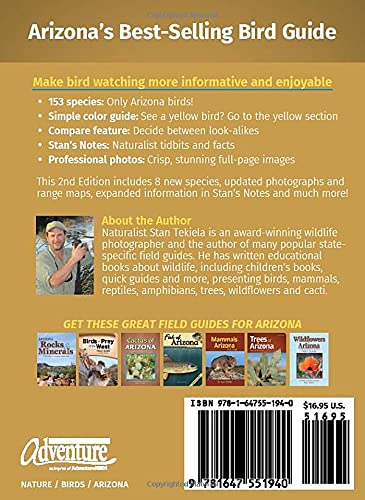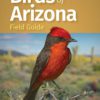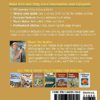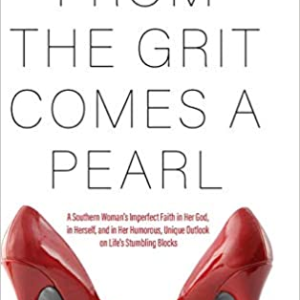Birds of Arizona Field Guide (Bird Identification Guides) Paperback – November 9, 2021 by Stan Tekiela
PAPERBACK
[384 pages]
PUB: November 09, 2021
Description
Author: Tekiela Stan
Edition: 2
Package Dimensions: 18x152x490
Number Of Pages: 384
Release Date: 09-11-2021
Details: Product Description
Identify Birds with Arizona’s Best-Selling Bird Guide!
Make bird-watching in Arizona even more enjoyable. With Stan Tekiela’s famous bird guide, field identification is simple and informative. There’s no need to look through dozens of photos of birds that don’t live in your area. This handy book features 151 species of Arizona birds organized by color for ease of use. Full-page photographs present the species as you’ll see them in nature, and a “compare” feature helps you to decide between look-alikes.
Inside you’ll find:
151 species: Only Arizona birds!
Simple color guide: See a yellow bird? Go to the yellow section
Stan’s Notes: Naturalist tidbits and facts
Professional photos: Crisp, stunning images
This second edition includes six new species, updated photographs and range maps, expanded information, and even more of Stan’s expert insights. So grab Birds of Arizona Field Guide for your next birding adventure―to help ensure that you positively identify the birds that you see.
About the Author
Naturalist, wildlife photographer and writer Stan Tekiela is the author of more than 175 field guides, nature books, children’s books, wildlife audio CDs, puzzles and playing cards, presenting many species of birds, mammals, reptiles, amphibians, trees, wildflowers and cacti in the United States. With a Bachelor of Science degree in Natural History from the University of Minnesota and as an active professional naturalist for more than 25 years, Stan studies and photographs wildlife throughout the United States and Canada. He has received various national and regional awards for his books and photographs. Also a well-known columnist and radio personality, his syndicated column appears in more than 25 newspapers and his wildlife programs are broadcast on a number of Midwest radio stations.
Excerpt. © Reprinted by permission. All rights reserved.
American Goldfinch Spinus tristis
Size: 5″ (13 cm)
Male: A perky yellow bird with a black patch on forehead. Black tail with conspicuous white rump. Black wings with white wing bars. No marking on the chest. Dramatic change in color during winter, similar to female.
Female: dull olive yellow without a black forehead, with brown wings and white rump
Juvenile: same as female
Nest: cup; female builds; 1 brood per year
Eggs: 4-6; pale blue without markings
Incubation: 10-12 days; female incubates
Fledging: 11-17 days; female and male feed young
Migration: partial migrator, flocks of up to 20 birds move around North America
Food: seeds, insects, will come to seed feeders
Compare: Pine Siskin (pg. 81) has streaked chest and yellow wing bars. The female House Finch (pg. 83) has a heavily streaked white chest. Male Yellow Warbler (pg. 295) is all yellow with orange streaks on chest. Male Wilson’s Warbler (pg. 287) lacks black wings.
Stan’s Notes: Most often found in open fields, scrubby areas and in woodlands. Often called Wild Canary. A feeder bird that enjoys Nyjer seed. Late summer nesting, uses the silky down from wild thistle for nest. Appears roller-coaster-like in flight. Listen for it to twitter during flight. Almost always in small flocks. Moves only far enough south to find food.
Be the first to review “Birds of Arizona Field Guide (Bird Identification Guides) Paperback – November 9, 2021 by Stan Tekiela”
You must be <a href="https://webdelico.com/my-account/">logged in</a> to post a review.






























There are no reviews yet.